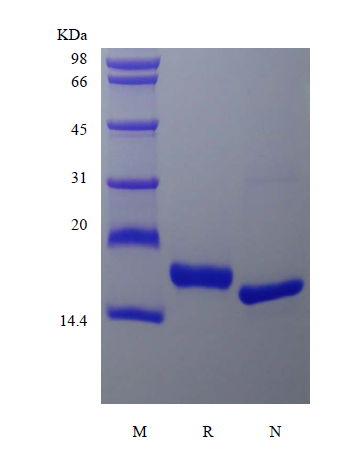- Synonyms
- Flt3L, SL cytokine
- Source
- Escherichia coli.
- Molecular Weight
- Approximately 18.0 kDa, a single non-glycosylated polypeptide chain containing 159 amino acids.
- AA Sequence
- TQDCSFQHSP ISSDFAVKIR ELSDYLLQDY PVTVPSNLQD EELCGALWRL VLAQRWMERL KTVAGSKMQG LLERVNTEIH FVTKCAFQHP PSCLRFVQTN ISRLLQETSE QLVALKPWIT RQNFSRCLEL QCQPDSSTLP PPRSPGALEA TALTAPQRP
- Purity
- > 97 % by SDS-PAGE and HPLC analyses.
- Biological Activity
- Fully biologically active when compared to standard. The ED50 as determined by a cell proliferation assay using human AML5 cells is less than 1.0 ng/ml, corresponding to a specific activity of > 1.0 × 106 IU/mg.
- Physical Appearance
- Sterile Filtered White lyophilized (freeze-dried) powder.
- Formulation
- Lyophilized from a 0.2 μm filtered solution in PBS, pH 7.4.
- Endotoxin
- Less than 1 EU/μg of rRhFlt-3L as determined by LAL method.
- Reconstitution
- We recommend that this vial be briefly centrifuged prior to opening to bring the contents to the bottom. Reconstitute in sterile distilled water or aqueous buffer containing 0.1 % BSA to a concentration of 0.1-1.0 mg/mL. Stock solutions should be apportioned into working aliquots and stored at ≤ -20 °C. Further dilutions should be made in appropriate buffered solutions.
- Stability & Storage
- Use a manual defrost freezer and avoid repeated freeze-thaw cycles.
- 12 months from date of receipt, -20 to -70 °C as supplied.
- 1 month, 2 to 8 °C under sterile conditions after reconstitution.
- 3 months, -20 to -70 °C under sterile conditions after reconstitution.
- Usage
- This material is offered by Shanghai PrimeGene Bio-Tech for research, laboratory or further evaluation purposes. NOT FOR HUMAN USE.
- SDS-PAGE

- Reference
- 1. Hacein-Bey S, Basile GD, Lemerle J, et al. 1998. Blood, 92: 4090-7.
2. Peters M, Solem F, Goldschmidt J, et al. 2001. Exp Hematol, 29: 146-55.
3. Beq S, Fontanet A, Theze J, et al. 2004. AIDS, 18: 2089-91.
4. Mahadevan D, Choi J, Cooke L, et al. 2009. Hum Genomics Proteomics, 2009: 453634.
5. Coates PT, Barratt-Boyes SM, Zhang L, et al. 2003. Blood, 102: 2513-21.
- Background
- Flt-3 ligand (FL) is a recently identified hematopoietic cytokine whose activities are mediated by binding to the transmembrane glycoprotein Flt-3. Flt-3 was first discovered as a member of the class III subfamily of receptor tyrosine kinases (RTK) whose expression among hematopoietic cells was found to be restricted to highly enriched stem/progenitor cell populations. Additionally, class III RTKs include the receptors from SCF, M-CSF and PDGF. Not surprisingly, Flt-3 ligand is also structurally related to M-CSF and SCF. All three cytokines have been shown to exist both as type I transmembrane proteins and as soluble proteins. The predominant human FL isoform is a transmembrane protein that can undergo proteolytic cleavage to generate a soluble form of the protein. FL has been shown to synergize with a wide variety of hematopoietic cytokines to stimulate the growth and differentiation of early hematopoietic progenitors.







 COA申请
COA申请
